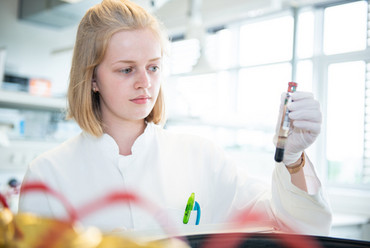Research biobanks
Central COFONI Technology Platform

Biobanks are responsible for the collection, processing, storage, and release of biospecimens and thus form the basis of a large part of medical research. Decisive for future analyses is the quality and standardisation of the processes. Biobanks form the basis for different research projects within COFONI.
The Hannover Unified Biobank (HUB) is the central biobank of Hannover Medical School (MHH). It was established in 2012 to provide an infrastructure for the standardised collection and storage of high-quality biospecimens and associated data. Over the years, the biobank has expanded and now supports many Germany-wide multicentre studies. Headed by Professor Thomas Illig, the HUB has developed into one of the largest state-of-the-art biobanks in Germany and today manages approximately 3.22 million diverse biospecimens for a range of diseases.
The Central Biobank of the University Medical Centre Göttingen (UMG) was founded in 2015 as a central service facility of the UMG to support medical research. Through close collaboration with the UMG Laboratory (Central Laboratory) and the Institutes of Pathology and Neuropathology, processes for the collection and processing of liquid and solid biospecimens and parallel data acquisition have been standardised. To enrich the biospecimens with clinical data from patients, the Central Biobank exchanges information closely with the Medical Data Integration Center. It supports national as well as international multicenter studies while providing a prospective collection of biospecimens and data that researchers can access.
Since 2017, the Central Biobank UMG and the HUB have been members of the German Biobank Alliance (GBA), a German biobank excellence network funded by the Federal Ministry of Education and Research. Today, more than 30 biobanks of university hospitals and an IT expert centre are members of the GBA. The members have established uniform quality standards and provide biospecimens for various national and international research projects. Since 2017, Professor Thomas Illig has been the deputy spokesperson of the GBA. Furthermore, he is one of five coordinators of the National Research Network of University Medicine (NUM) in the field of "Cohorts and Biobanking" (NAPKON). PD Dr. Sara Nußbeck is a member of the GBA Steering Committee and leads the GBA subproject Education and Training.
As part of the Network of University Medicine, the National Pandemic Cohort Network (NAPKON) was funded, which recruits patients for COVID-19 research at 36 sites across Germany and stores the collected biospecimens locally. Patients are enrolled in three cohort platforms, the high-resolution platform (HAP), the cross-sector platform (SÜP), or the population-based platform (POP), and followed longitudinally until three years after infection. NAPKON makes the collected data and biospecimens available to research projects through a use and access process. The various NAPKON infrastructure cores subsequently process approved applications and provide the required data and biospecimens. The HUB is part of the infrastructure and, as a biospecimen core, is responsible for requesting the requested biospecimens from the individual sites and sending the biospecimens collectively to the applicants. The UMG participates in the biospecimen collection of the SÜP for the Göttingen site with 118 patients included so far (5th place of the university sites recruiting for SÜP), and the HUB participates in the biospecimen collection for the Hannover site in the HAP. Professor Thomas Illig is one of the five principal investigators in NAPKON, spokesperson for the biospecimen core, and serves on the Steering Committee and Use & Access Committee.
The NAPKON cohort currently includes a total of 6,715 patients with over 500,000 biospecimens. A comprehensive data set will be collected on the collected biospecimens in accordance with the "German Corona Consensus" (GECCO) with clinical data, diagnostics, interventions, demographic data, treatments, imaging data, and, as needed, specific data sets (pediatrics, neurology, etc.). A total of 2,520 patients in the cohort were systematically characterized for baseline, acute course, and a three-month follow-up. Ongoing analyses of this characterization include genotyping with GSA chips, transcriptomics and epigenetic profiling with EPIC array, ATAC-seq and ChIP-seq, proteomics, metabolomics, and a cytokine panel as well as viral typing, serum PCR, and serological spike, nucleocapsid, and neutralizing antibody assays. Subsequently, 600 patients of the analyzed collective will be selected on the basis of a post-COVID syndrome score and their 12-month follow-up will also be molecularly characterized. The planned analyses include transcriptomics and epigenetic profiling with EPIC array, ATAC-seq and ChIP-seq, proteomics, metabolomics, and a cytokine panel. All generated results of these analyses can be submitted to the Use & Access procedure in NAPKON.
Through funding from the Lower Saxony Ministry of Science and Culture (MWK), a longitudinal COVID-19 cohort with broad clinical data and diverse biospecimens has additionally been established at the HUB since 2020 under the direction of Professor Thomas Illig. In addition, data and biosamples are included from the Göttingen site (PD Dr. Sara Nußbeck, Central Biobank UMG). Together, data and biosamples from more than 400 patients are thus available. The cohort at the Hannover site will be continued by existing study personnel depending on the number of infected patients and will be continuously enlarged.
The biospecimen collection with MWK funding currently comprises more than 30,000 samples in Hannover alone, and more than 10% of these were already assigned for analysis to a large number of research groups. The molecular characterization of the cohort was partly performed by the institutes themselves as well as in the context of COFONI projects. (i) Genome sequencing was performed from 140 patients and transcriptome sequencing from 210 clinically relevant time points. The generated omics data were already published within the German COVID-19 OMICS Initiative (Decoi) as well as the Host Genetics Initiative (HGI), and currently three additional research groups are working on the analysis of the data. (ii) The epigenome of 227 clinically relevant time points was longitudinally characterized and will be analyzed integratively together with the genome and transcriptome data as well as the clinical data. (iii) Furthermore, structural variants in 60 patients were investigated by optical genome mapping and preliminary results were already published. (iv) Genomic variants were investigated and published in an international Genome Wide Association Study (GWAS). (v) The immune response of the cohort was characterized using cytokines and leukocyte populations from plasma samples, and (vi) the heterologous immunity of the cohort was examined using B and T cell populations using Peripheral Blood Mononuclear Cells (PBMCs) from 128 time points. (vii) The transcriptome of specific cell types was analyzed using single-cell sequencing. (viii) Other projects include studying circulating non-coding RNAs and analyzing the metabolome profiles of long-COVID patients compared to convalescent patients. The projects can draw on an extensive set of clinical data, which was additionally collected for all severe and moderately severe visits following the German Corona Consensus (GECCO) dataset and the WHO clinical progression scale as well as a detailed post-COVID dataset established by the Pneumology Department of the MHH. Remaining gaps in the characterization of the cohort, especially in the study of post-COVID visits, can continue to be filled within the research network COFONI. In this context, the analyses will be performed at the Hannover and Göttingen sites according to their expertise. The data collection will be continuously expanded.
Thus, with the close ties of the biobanks in Göttingen and Hannover to the German Biobank Alliance (GBA), expertise in quality management and harmonization in accordance with national and international standards is provided. The two biobanks prepare the samples appropriately (e.g., extraction of DNA and RNA or preparation of cell cultures) and send the samples to scientists for characterisation. The molecular data can be stored in the HUB in a systematic manner in the BIMS (Biobank Information Management System). This is done in close coordination with the Department of Medical informatics and the computation centers of the participating institutions.
Contact
Research biobanks

Prof. Dr. Thomas Illig
Head of the Hannover Unified Biobank
Medizinische Hochschule Hannover
Feodor-Lynen-Str. 15
30625 Hannover
Illig.Thomas(at)mh-hannover.de
Dr. Stefanie Mücke
Project Manager „COFONI“ of the Hannover Unified Biobank
Medizinische Hochschule Hannover
Feodor-Lynen-Str. 15
30625 Hannover
Muecke.Stefanie(at)mh-hannover.de
Dr. Sonja Volland
Project Manager „COVID-19 Biobank“ of the Hannover Unified Biobank
Medizinische Hochschule Hannover
Feodor-Lynen-Str. 15
30625 Hannover
Volland.Sonja(at)mh-hannover.de

PD Dr. Sara Nußbeck
Head Central Biobank UMG
Universitätsmedizin Göttingen
Georg-August-Universität Göttingen
Zentrale Biobank UMG
Robert-Koch-Str. 40
37075 Göttingen
sara.nussbeck(at)med.uni-goettingen.de

Dr. Kristin Hummel
Project Manager Central Biobank UMG
Universitätsmedizin Göttingen
Georg-August-Universität Göttingen
Zentrale Biobank UMG
Robert-Koch-Str. 40
37075 Göttingen
kristin.hummel(at)med.uni-goettingen.de
Downloads
Guideline for the Use of the Technology Platform Research Biobanks
This guideline covers the specific regulations for the use of the technology platform Research Biobanks. The regulations apply to all COFONI-funded projects.